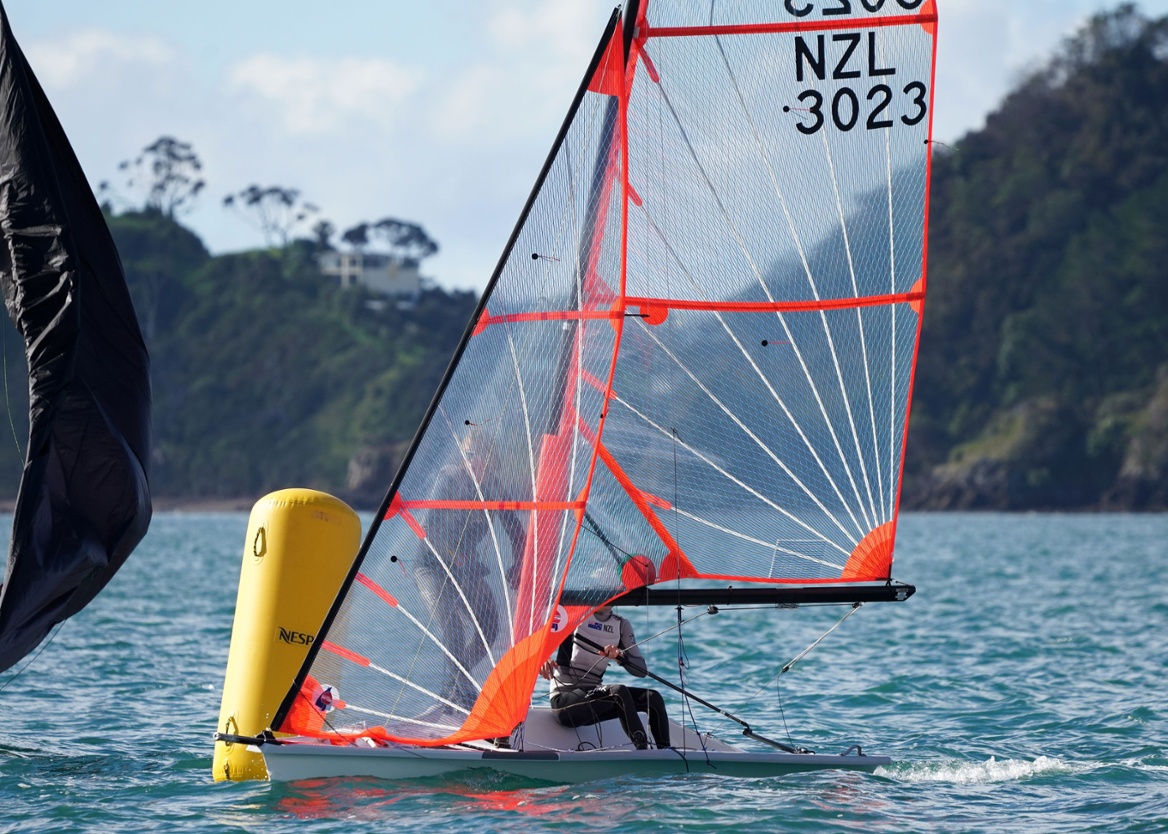Some tuning tips by Scott Babbage :
2nd & 3rd 29er Worlds
A 29er is a very simple boat to tune, there are few adjustments. Now it's possible to get around at the front of the fleet with a variety of settings compared to the competition. It all depends on how you sail the boat and what you're trying to achieve at the time.
It is key (and simple) to understand the impact each adjustment has on your boat, then you can make your own call on when you'd change one or the other.
So here goes...
1. Main sheet Simple. More main = more power. Eased to keep the boat flat, but not before maximum crew weight is used. Kept on centreline to provide height. Used to maintain leech tension without vang. Kept close to centre downwind to keep the mast up, spinnaker luff on and steering balanced.
2. Jib sheet More jib = more power. Too much jib = stall. Sheet cracked 1-2 to breathe when required (ie. chop, gusts, speed). Eased completely on tight spinnaker legs to get height. Eased lots downwind keeps the bow up.
3. Spinnaker sheet Just enough spinnaker sheet to have the luff folding or close to folding. Eased significantly on gust onset to allow the boat to breathe and accelerate.
4. Main halyard Up. All the way. 1-2 off mast tip brings sail down mast, changing vang and bridle positions.
5. Jib halyard Controls jib depth at luff. Tighter = flat. Loose = power.
6. Spinnaker halyard Eased flattens luff and curls leech. Tight fills luff and opens leech.
7. Spinnaker tack line Same as spinnaker halyard. Not getting full extension of spinnaker tack from bow.
8. Outhaul Eased = depth down low. Pull on = flat. Works in combination with downhaul on main to flatten foot.
9. Downhaul More downhaul = flatter. More downhaul bends mast and brings draft forward, opens leech.
10. Vang More vang = flatter low down. More vang = tighter leech. More vang = more low-down mast bend.
11. Batten tension More tension forces shape into sail. Less allows the sail to do whatever it wants.
12. Shroud pin position Lower = more tension. More tension = less forestay sag. More tension = more mast bend.
13. Mast heel tune Correct heel tune = stiffer lower mast.
14. Steering Simple: uphill up gives height but not speed, down is opposite. Downhill up gives speed but not depth. Down is opposite.
15. Jib track position Opens slot between jib and main. Outer positions allow more sheet tension to be used for similar slot, therefore tighter leech.
16. Jib clew-board position Upper hole gives depth down low for same leech tension. Lower hold gives flat down low for same leech tension, or less leech tension for same flatness down low.
17. Spinnaker pole length Longer puts spinnaker further away from rest of rig which helps to lift bow.
18. Centreboard Up reduces power. Down provides more lift/pointing ability.
19. Main bridle Higher keeps boom on centreline with less sheet tension. Lower allows more vang/sheet tension to be used.
20. Rudder angle Tip in makes steering lighter.
21. Forestay length Longer provides more rake, better for heavier conditions. Shorter provides less rake, better for lighter conditions.
22. Rig tension See shroud pin positions.
23. Spreaders (if they were adjustable) Up gives less poke therefore softer mid-mast. Forward/down gives stiffer mid-mast.
24. Leech lines Stops leech vibration. Rolls last inch of sail to windward.
25. Spinnaker luff line Similar to leech line.
26. Trapeze height Down provides more weight for the wire.
27. Boat heel More heel = more wetted surface.
28. Fore-aft trim Aft lifts bow and rakes rig. Forward sinks bow and provides pointing ability, less wetted surface.

